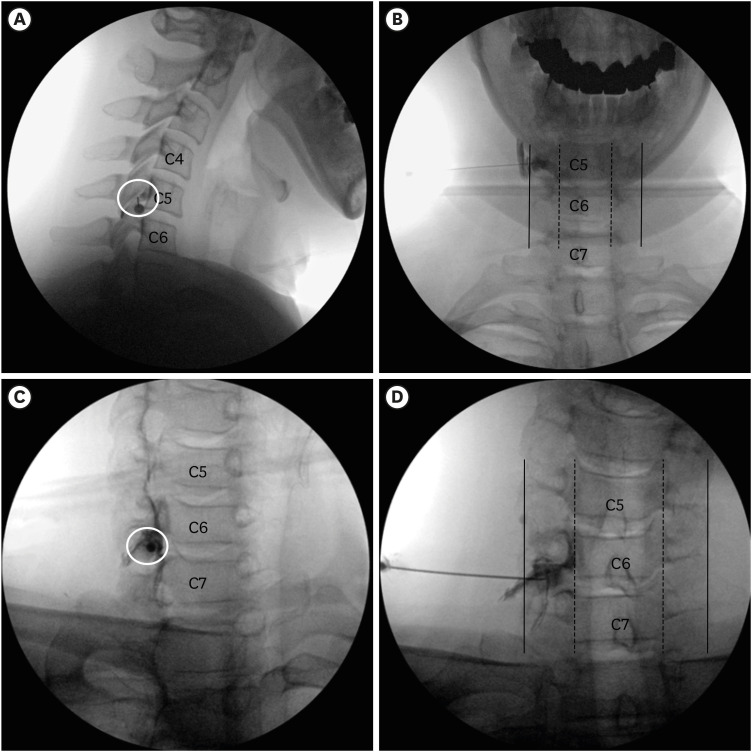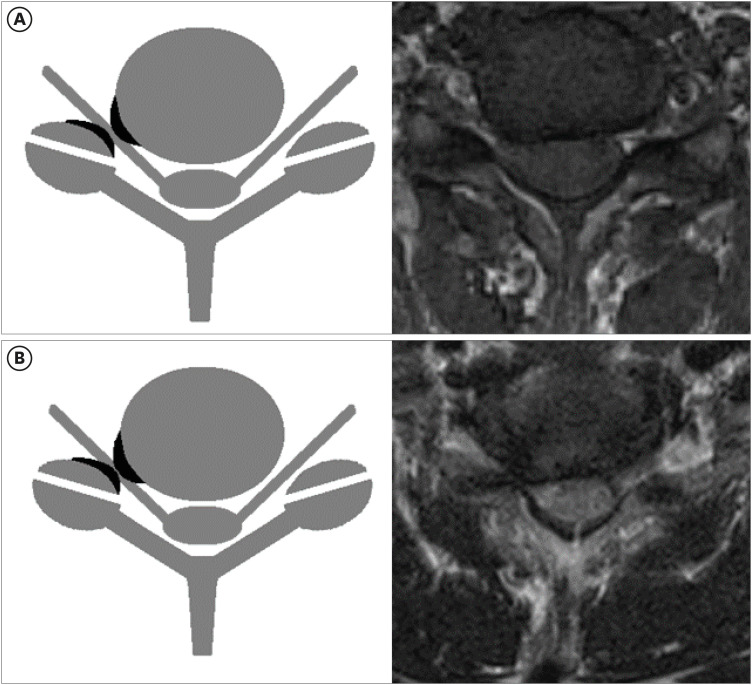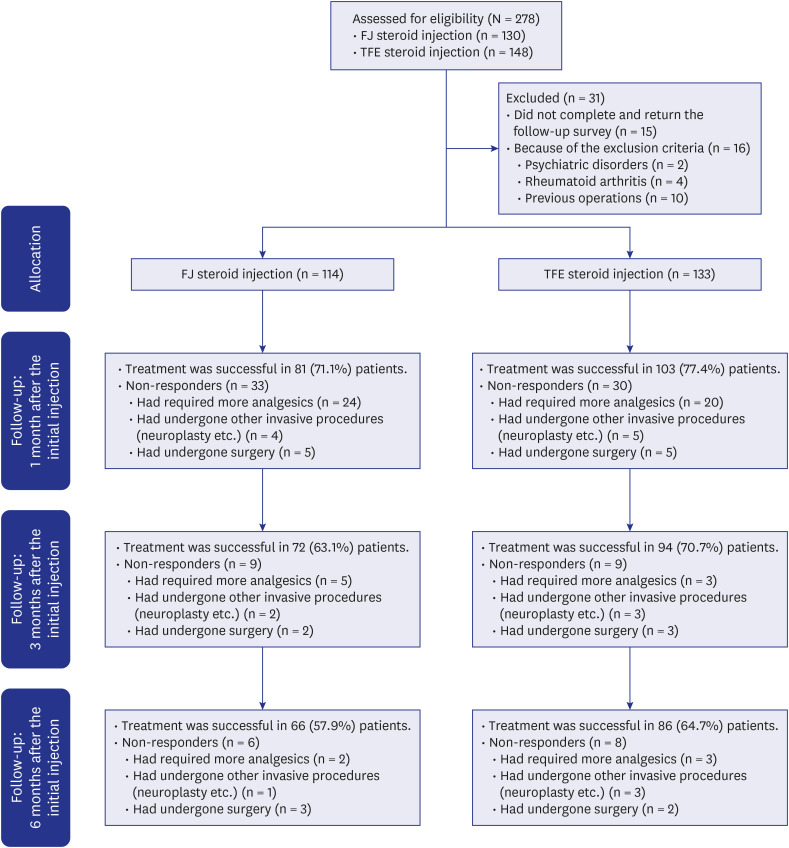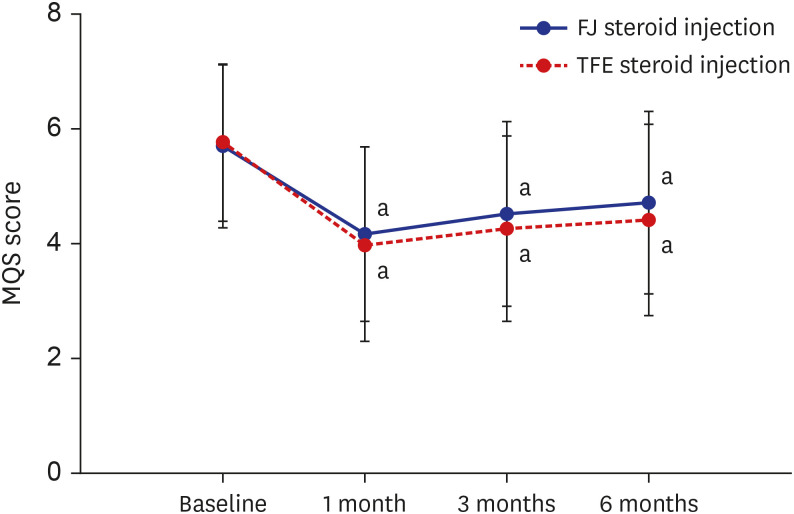J Korean Med Sci.
2022 Jun;37(25):e208. 10.3346/jkms.2022.37.e208.
Facet Joint Versus Transforaminal Epidural Steroid Injections in Patients With Cervical Radicular Pain due to Foraminal Stenosis: A Retrospective Comparative Study
- Affiliations
-
- 1Department of Anesthesiology and Pain Medicine, College of Medicine, Ewha Womans University, Seoul, Korea
- 2Department of Anesthesiology and Pain Medicine, College of Medicine, Ewha Womans University, Ewha Womans University Mokdong Hospital, Seoul, Korea
- KMID: 2530839
- DOI: http://doi.org/10.3346/jkms.2022.37.e208
Abstract
- Background
A cervical transforaminal epidural (TFE) steroid injection is a useful treatment option for cervical radicular pain, but it carries a small risk of catastrophic complications. Several studies have reported that cervical facet joint (FJ) steroid injection can reduce cervical radicular pain through an indirect epidural spread. The aim of this retrospective comparative study was to evaluate the pain scores and functional disability in subjects receiving cervical FJ or TFE steroid injection for the treatment of cervical radicular pain due to foraminal stenosis (FS).
Methods
We selected 278 patients 18 years of age and older who underwent cervical FJ (n = 130) or TFE (n= 148) steroid injection for cervical radicular pain. The primary outcomes included pain scores and functional disability during hospital visits one, three, and six months after the initial injection. Secondary outcomes were the proportion of responders and Medication Quantification Scale (MQS) scores. Adverse events and variables correlating with effectiveness one month after the initial injection were also evaluated.
Results
The Numeric Rating Scale and Neck Disability Index scores showed a significant improvement one, three, and six months after the initial injection in both groups, with no significant differences between the groups. No significant differences were observed in the success rates of the procedure one, three, and six months after the initial injection for either group. There were no significant differences in MQS between the groups during the followup period. Univariate and multivariate logistic regression analyses revealed that the injection method, age, sex, number of injections, FS severity, MQS, pain duration, and the presence of cervical disc herniation were not independent predictors of treatment success.
Conclusion
The efficacy of FJ steroid injection may not be inferior to that of TFE steroid injection in patients with cervical radicular pain due to FS.
Keyword
Figure
Reference
-
1. Kim MS, Lee DG, Chang MC. Outcome of transforaminal epidural steroid injection according to severity of cervical foraminal stenosis. World Neurosurg. 2018; 110:e398–e403. PMID: 29138074.
Article2. Carette S, Fehlings MG. Clinical practice. Cervical radiculopathy. N Engl J Med. 2005; 353(4):392–399. PMID: 16049211.3. Radhakrishnan K, Litchy WJ, O’Fallon WM, Kurland LT. Epidemiology of cervical radiculopathy. A population-based study from Rochester, Minnesota, 1976 through 1990. Brain. 1994; 117(Pt 2):325–335. PMID: 8186959.4. Sampath P, Bendebba M, Davis JD, Ducker T. Outcome in patients with cervical radiculopathy. Prospective, multicenter study with independent clinical review. Spine (Phila Pa 1976). 1999; 24(6):591–597. PMID: 10101827.5. Kim J, Kim K, Lee M, Kim S. Correlation between intravascular injection rate, pain intensity, and degree of cervical neural foraminal stenosis during a cervical transforaminal epidural block. J Pain Res. 2021; 14:3017–3023. PMID: 34594132.
Article6. Bureau NJ, Moser T, Dagher JH, Shedid D, Li M, Brassard P, et al. Transforaminal versus intra-articular facet corticosteroid injections for the treatment of cervical radiculopathy: a randomized, double-blind, controlled study. AJNR Am J Neuroradiol. 2014; 35(8):1467–1474. PMID: 24874533.
Article7. Bureau NJ, Moser TP, Gouvion A, Julien AS. CT fluoroscopy-guided transforaminal and intra-articular facet steroid injections for the treatment of cervical radiculopathy: injectate distribution patterns and association with clinical outcome. Eur Radiol. 2020; 30(11):5933–5941. PMID: 32500194.
Article8. Kim H, Lee SH, Kim MH. CT guided cervical transforaminal steroid injection: 2 months follow-up. Korean J Pain. 2006; 19(1):51–55.
Article9. Scanlon GC, Moeller-Bertram T, Romanowsky SM, Wallace MS. Cervical transforaminal epidural steroid injections: more dangerous than we think? Spine (Phila Pa 1976). 2007; 32(11):1249–1256. PMID: 17495784.10. Anderberg L, Annertz M, Persson L, Brandt L, Säveland H. Transforaminal steroid injections for the treatment of cervical radiculopathy: a prospective and randomised study. Eur Spine J. 2007; 16(3):321–328. PMID: 16835737.
Article11. Kloth DS, Calodney AK, Derby R, Lagattuta FP, O’Neill C, Yurth E, et al. Improving the safety of transforaminal epidural steroid injections in the treatment of cervical radiculopathy. Pain Physician. 2011; 14(3):285–293. PMID: 21587332.12. Richarme D, Feydy A, Fayad F, Jourdan C, Rannou F, Drapé JL, et al. Cervical radiculopathy: efficiency of CT-guided cervical facet joint corticosteroid injection: 47. In : Swiss Radiological Congress 2010, Schweizerische Gesellschaft für Radiologie, Schweizerische Gesellschaft für Nuklearmedizin, Schweizerische Vereinigung der Fachleute für medizinisch technische Radiologie; 2010 Jun 3-5; Lugano, Switzerland. Lugano, Switzerland: Swiss Medical Forum;2010.13. Kelekis A, Filippiadis DK, Velonakis G, Martin JB, Oikonomopoulos N, Brountzos E, et al. Fluoroscopically guided infiltration of the cervical nerve root: an indirect approach through the ipsilateral facet joint. Pain Physician. 2014; 17(4):291–296. PMID: 25054388.14. van Eerd M, Patijn J, Lataster A, Rosenquist RW, van Kleef M, Mekhail N, et al. 5. Cervical facet pain. Pain Pract. 2010; 10(2):113–123. PMID: 20415728.15. Kirpalani D, Mitra R. Cervical facet joint dysfunction: a review. Arch Phys Med Rehabil. 2008; 89(4):770–774. PMID: 18374011.
Article16. Park KD, Lee WY, Nam SH, Kim M, Park Y. Ultrasound-guided selective nerve root block versus fluoroscopy-guided interlaminar epidural block for the treatment of radicular pain in the lower cervical spine: a retrospective comparative study. J Ultrasound. 2019; 22(2):167–177. PMID: 30519991.
Article17. Vernon H, Mior S. The Neck Disability Index: a study of reliability and validity. J Manipulative Physiol Ther. 1991; 14(7):409–415. PMID: 1834753.18. Song KJ, Choi BW, Choi BR, Seo GB. Cross-cultural adaptation and validation of the Korean version of the neck disability index. Spine (Phila Pa 1976). 2010; 35(20):E1045–E1049. PMID: 20436378.
Article19. Jensen MP, Smith DG, Ehde DM, Robinsin LR. Pain site and the effects of amputation pain: further clarification of the meaning of mild, moderate, and severe pain. Pain. 2001; 91(3):317–322. PMID: 11275389.
Article20. Hartrick CT, Kovan JP, Shapiro S. The numeric rating scale for clinical pain measurement: a ratio measure? Pain Pract. 2003; 3(4):310–316. PMID: 17166126.
Article21. Harden RN, Weinland SR, Remble TA, Houle TT, Colio S, Steedman S, et al. Medication Quantification Scale version III: update in medication classes and revised detriment weights by survey of American Pain Society Physicians. J Pain. 2005; 6(6):364–371. PMID: 15943958.
Article22. Kim S, Lee JW, Chai JW, Yoo HJ, Kang Y, Seo J, et al. A new MRI grading system for cervical foraminal stenosis based on axial T2-weighted images. Korean J Radiol. 2015; 16(6):1294–1302. PMID: 26576119.
Article23. Gallizzi M, Gagnon C, Harden RN, Stanos S, Khan A. Medication Quantification Scale version III: internal validation of detriment weights using a chronic pain population. Pain Pract. 2008; 8(1):1–4. PMID: 18211588.
Article24. Bland JH, Boushey DR. Anatomy and physiology of the cervical spine. Semin Arthritis Rheum. 1990; 20(1):1–20. PMID: 2218549.
Article25. Flannigan BD, Lufkin RB, McGlade C, Winter J, Batzdorf U, Wilson G, et al. MR imaging of the cervical spine: neurovascular anatomy. AJR Am J Roentgenol. 1987; 148(4):785–790. PMID: 3493665.
Article26. Olmarker K, Byröd G, Cornefjord M, Nordborg C, Rydevik B. Effects of methylprednisolone on nucleus pulposus-induced nerve root injury. Spine (Phila Pa 1976). 1994; 19(16):1803–1808. PMID: 7973978.
Article27. Malhotra G, Abbasi A, Rhee M. Complications of transforaminal cervical epidural steroid injections. Spine (Phila Pa 1976). 2009; 34(7):731–739. PMID: 19333107.
Article28. Manchikanti L, Malla Y, Wargo BW, Cash KA, Pampati V, Fellows B. Complications of fluoroscopically directed facet joint nerve blocks: a prospective evaluation of 7,500 episodes with 43,000 nerve blocks. Pain Physician. 2012; 15(2):E143–E150. PMID: 22430660.29. Dwyer A, Aprill C, Bogduk N. Cervical zygapophyseal joint pain patterns. I: A study in normal volunteers. Spine (Phila Pa 1976). 1990; 15(6):453–457. PMID: 2402682.30. Silbergleit R, Mehta BA, Sanders WP, Talati SJ. Imaging-guided injection techniques with fluoroscopy and CT for spinal pain management. Radiographics. 2001; 21(4):927–939. PMID: 11452067.
Article31. Kulkarni AG, Sabet T, Ashley H, Diwan AD. Technical note: the swimmer’s view for cervical facet joint injections. Eur Spine J. 2006; 15(7):1150–1152. PMID: 16676153.
Article32. Senoglu N, Senoglu M, Safavi-Abbasi S, Shedd SA, Crawford NR. Morphologic evaluation of cervical and lumbar facet joints: intra-articular facet block considerations. Pain Pract. 2010; 10(4):272–278. PMID: 20230452.
Article33. Won HS, Jang HY, Moon HS, Zhu PB, Kim YD, Kim H. Fluoroscopic findings of extra-cervical facet joint flow and its incidence on cervical facet joint arthrograms. J Clin Med. 2020; 9(12):E3919. PMID: 33276698.
Article34. Won HS, Yang M, Kim YD. Facet joint injections for management of low back pain: a clinically focused review. Anesth Pain Med (Seoul). 2020; 15(1):8–18. PMID: 33329784.
Article35. Hwang SY, Lee JW, Lee GY, Kang HS. Lumbar facet joint injection: feasibility as an alternative method in high-risk patients. Eur Radiol. 2013; 23(11):3153–3160. PMID: 23756957.
Article
- Full Text Links
- Actions
-
Cited
- CITED
-
- Close
- Share
- Similar articles
-
- Selective Epidural Steroid Injection in a Patient with Refractory Radicular Leg Pain: A case report
- Percutaneous Adhesiolysis Versus Transforaminal Epidural Steroid Injection for the Treatment of Chronic Radicular Pain Caused by Lumbar Foraminal Spinal Stenosis: A Retrospective Comparative Study
- Oblique interlaminar lumbar epidural steroid injection for management of low back pain with lumbosacral radicular pain: A case report
- Acute Cervical Subdural Hematoma with Quadriparesis after Cervical Transforaminal Epidural Block
- Effect of Transforaminal Epidural Injection in Patients with Lumbar Radicular Pain








